The genetically modified fish with fluorescence (glow), known as GloFish, have firmly established their niche in the aquarium hobby and have found their fans. These aquatic inhabitants were created exclusively for scientific purposes, but the striking bright color, which is also inherited, could not go unnoticed among aquarists. In this article, we will tell you about the fish that marked the beginning of a new milestone in the aquarium hobby – zebrafish glofish.
General information
Danio glofish is an artificial form of the popular aquarium fish zebrafish (Danio rerio), a distinctive feature of which is fluorescence – the ability of cells of living organisms under certain conditions to emit photons of light, in other words, to glow.
To achieve a similar effect, scientists used genes from marine coelenterates (corals and jellyfish), among which glow in the dark is widespread. The genes responsible for the synthesis of fluorescent proteins were inserted into the DNA of the zebrafish, after which fish with a bright color appeared from the eggs, “flashing” under blue lamps.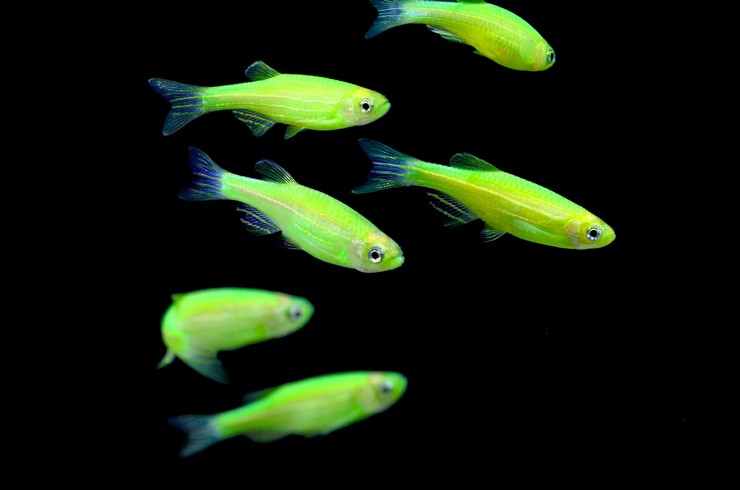
It is worth noting that the glow of genetically modified zebrafish glofish has nothing to do with coloring fish with paints and does not pose any threat at all to humans and to the aquatic inhabitants themselves. Moreover, the “glow” gene is inherited by the next generations. According to the conditions of keeping and feeding, the fish are absolutely no different from their natural counterparts.
Appearance
Danio glofish has a graceful, elongated body 3-6 cm long. The fins are short, almost transparent, the tail is single. The small head has a small upper mouth and relatively large eyes.
The main feature and value of zebrafish glofish is its bright fluorescent coloration, which depends on whose genes were introduced into the fish’s DNK. For example, the jellyfish gene GFP gives zebrafish green, the coral gene RFP gives red, and their combination gives us the yellow color of zebrafish.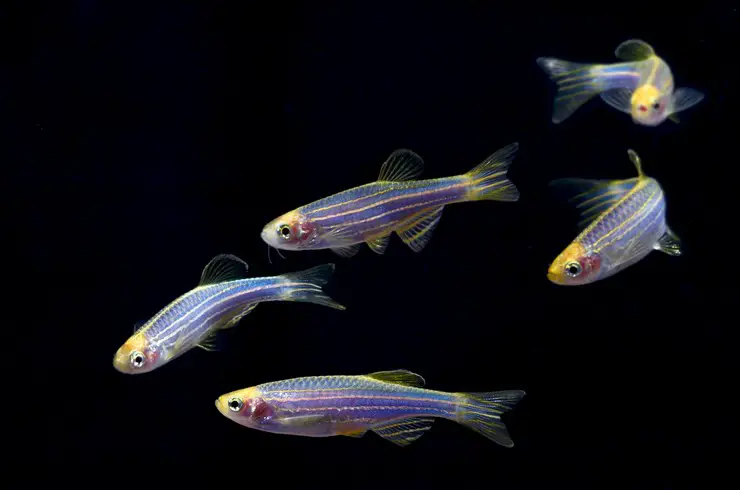
Zebrafish are currently available in the following colors: Electric Green, Sunburst Orange, Cosmic Blue, Galactic Purple, and Starfire Red. ).
Habitat
Danio glofish are not found in wildlife. This form was created by scientists with an important scientific and practical purpose – to obtain an indicator fish, the change in color of which would indicate the presence of hazardous compounds in the water. But by a fortunate coincidence, a representative of a company selling aquarium fish was present at one of the conferences at which zebrafish glofish were demonstrated. This is how the first batch of glowing zebrafish was ordered, which was the beginning of their “career” in the aquarium hobby.
Care and maintenance
Danio glofish are schooling fish, so they must be kept in groups of at least 5 pieces. For such a number of individuals, an aquarium of 30 liters or more will be enough. From their progenitors, the zebrafish glofish received natural endurance and an active lifestyle. It is better to cover the aquarium with a lid to avoid the fish jumping out. They prefer to stay in the upper layers of the aquarium.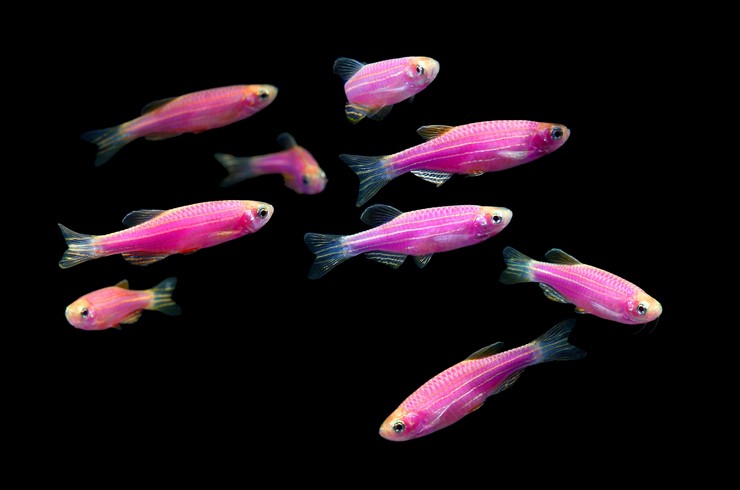
It is best to decorate the aquarium with special luminous decorations. On sale, you can find soil, artificial plants, various figurines. Like the fish, they will glow in the blue color of the lamps, which will create interesting futuristic designs. However, this does not mean at all that the natural style is not suitable for zebrafish glofish. Fish feel great in the thickets of living plants.
The water for keeping zebrafish must be clean and well aerated, and a suitable filter and compressor must be installed in the aquarium. It is better to use bright lighting – the fish will look much more spectacular. It is advisable that the aquarium has a built-in night light. It will allow you to watch the zebrafish glofish in all its glory.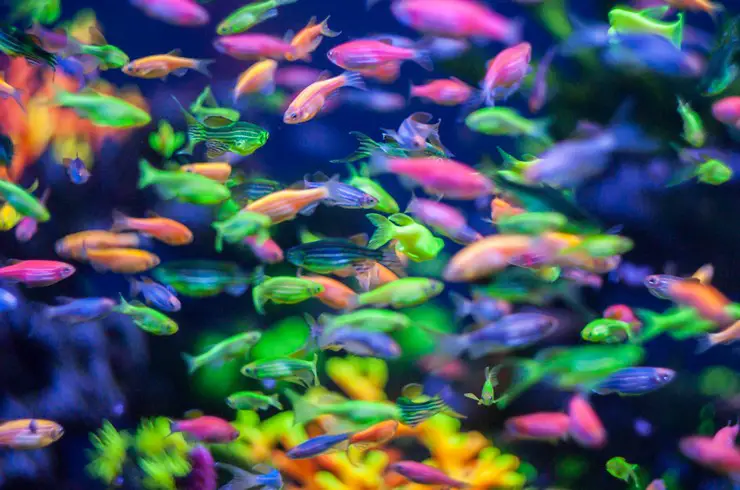
Do not forget about weekly water changes – up to 20% of the volume of the aquarium.
Compatibility
Danio glofish is a peaceful fish that is perfect for shared aquariums with small tropical species. Fish differ in that they swim mainly in the upper layers of the aquarium. Almost all aquarium fish are suitable neighbors for zebrafish glofish, which will not consider them as a food source. Commensurate schooling species: minors, tetras, neons will become good neighbors in the aquarium. Zebrafish also get along with guppies, swordtails, and scalars. Even badass cockerels often do not notice the presence of these mobile neighbors in the aquarium. Peaceful catfish will become excellent neighbors, you can opt for Ancistrus and corridors.
But joint keeping with large cichlids, large goldfish, brocade catfish is better to exclude.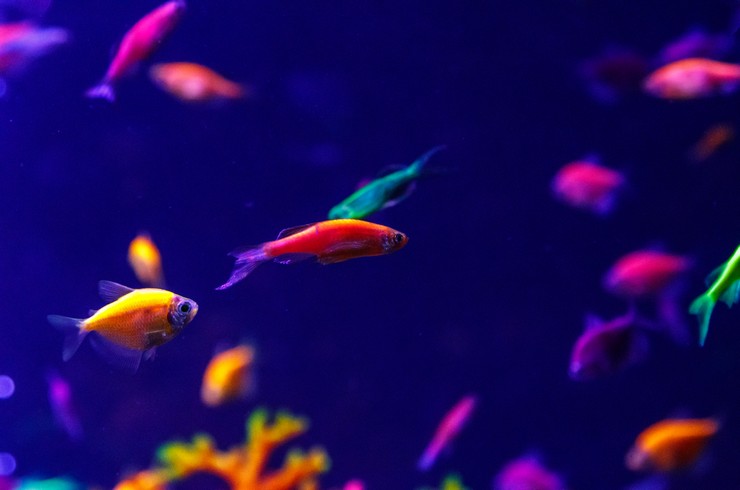
Feeding zebrafish glofish
When choosing the right food, you need to focus on the small size of the zebrafish glofish and their preference for feeding near the water surface. It is better to exclude from the diet defective live and frozen food, which can easily become a source of infections in the aquarium.
The following foods are excellent choices for feeding zebrafish glofish:
- Tetra Micro Crisps are chips made using a unique low-temperature technology that allows you to preserve even more nutrients. The balanced formula combines plant and animal ingredients.
- TetraMin Mini Granules is a complete feed in the form of high quality, slow sinking mini granules with functional ingredients, providing complete daily nutrition for small ornamental fish. Supports healthy growth and vitality of fish as well as bright colors.
- TetraPRO Energy Multi-Crisps is an incredibly nutritious food with an energy concentrate to stimulate vitality. Careful manufacturing technology allows you to preserve high nutritional value and preservation of vitamins, and the prebiotics included in the feed improves digestion.
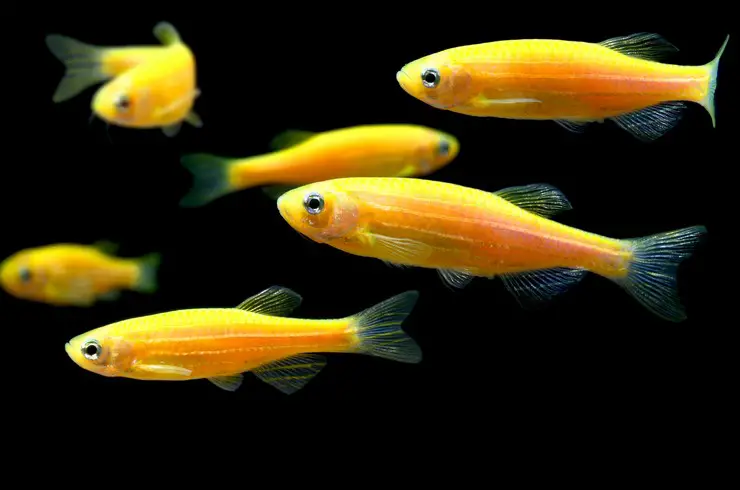
Reproduction and breeding
Breeding zebrafish glofish at home is not difficult at all. Fish become pubertal at the age of about six months. Distinguishing a male from a female is also quite easy: males are more slender, and females have a convex abdomen.
7-10 days before spawning, producers are seated and abundantly fed. Then they are combined in a separate spawning aquarium. It must have a volume of at least 30 liters. You don’t need to lay the soil, but a separator grid or Javanese moss will be needed so that the eggs are not eaten by the parents.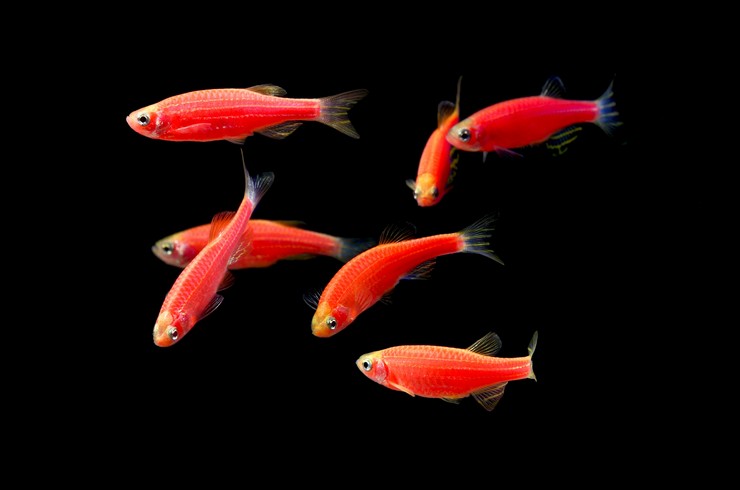
The water level in the spawning box should be about 6-10 cm, it is best to place the container near the window. Usually, 2-3 males and one female are planted for spawning, in the late afternoon, so that the process begins with sunrise. The males chase the female, knock out eggs from her and immediately fertilize. The fertility of zebrafish glofish is very high, it can reach up to 400 eggs. After spawning, the producers sit down.
Provided that the temperature in the spawning aquarium is maintained at a level of 26-28 ° C, the incubation of eggs lasts 30-36 hours. After hatching, the larvae attach to the walls of the aquarium and aquatic plants and later move on to self-feeding. Zebrafish grows quickly, so soon more fish will need to be transplanted into the aquarium.

